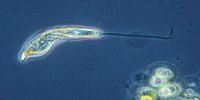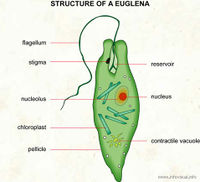Flagellates
Overview
Flagellates are unicellular microorganisms and are a part of the protozoa group. They are characterized by having one or more flagella, which is a hair-like whip organelle and very distinguishable. There are many different types of flagellates, and they all have different lifestyles. Some make up colonies and others live as single cells. The two main categories are phytoflagellates and zooflagellates. Phytoflagellates are green and plant-like creatures that use photosynthesis to produce food. Zooflagellates are colorless and animal-like. Parasitic flagellates also fall into this category.
Both phytoflagellates and zooflagellates can be found in ponds, lagoons, and even shallow puddles. Wherever there are large amounts of soluble food, flagellates can thrive. However, parasitic zooflagellates live inside the intestines or bloodstream of a host and can cause harmful diseases like giardiasis.
Types of Flagellates
Phytoflagellates
This group of flagellate protozoans have much in common with typical algae. Some actually contain the pigment chlorophyll and use a photosynthetic type of nutrition [10]. Flagellates that do not use photosynthesis as a source of food can also absorb nutrients through their body surface, or can ingest food particles. Species that are members of this group include but are not limited to Euglena, Chloromonad, Dinoflagellate, Cryptomonad, Chrysomonad. Phytoflagellates are considered as a group because (1) possession of a nucleus in the conventional sense and centriolar mitosis (2) mobility by means of flagella (3) photosynthetic pigments located in the plastids [11].
- Euglena
- Like all Flagellates, Euglena have a flagellum. They are green because they have chloroplasts, which are organelles that aid in photosynthesis and contain chlorophyll. They have a plasma membrane, which contains their cytoplasm and other organelles. The pellicle is a flexible membrane, which supports the plasma membrane. A contractile vacuole removes excess water from the cell, and a reservoir located near the flagellum expels the excess water. They also have a red eye spot, called a stigma, which is light sensitive and helps to guide their movement.
- Volvox
- A Volvox is a colony of freshwater algae that forms a hollow ball and can be made up of anywhere from 500-200,000 individual cells. Their flagella are pointed outward, and they move together as one in a spinning motion. They can be big enough to see with the naked eye. The Flagellates are connected by thin strands of cytoplasm, and can be green, red, or brown.
Zooflagellates
This group of flagellates are non-photosynthetic organisms compared to the other group of flagellates discussed in the previous section [12]. These flagellates lack cell walls and feed by either phagocytosis or endocytosis. This group of flagellates is one of the most diverse of all eukaryotes and have given rise to most other parts of the eukaryotic cells that we see today. Zooflagellates are classified over thirteen or fourteen phyla and are spread across four of the seven eukaryotic kingdoms that we have currently classified to date [12].
- Parasites
- Parasitic Flagellates are categorized under the name Zooflagellates because they do not have the means to produce their food through photosynthesis. One example of a parasitic Flagellate is Giardia. Giardia causes disease in humans when their cyst form is ingested through contaminated water. The cyst form serves as a protective dormant state for Giardia until it enters a host's small intestine, causing diarrhea and malabsorption. Some cyst form Giardia pass through the host's system, allowing it to infect others.
Reproduction
- Flagellates reproduce asexually, but in some cases, like that of the Volvox colony, they can reproduce sexually as well. The form of asexual reproduction is binary fission. This is the process where the organism duplicates its DNA and splits into two daughter cells. Most flagellates use this process. A Volvox uses a slightly different process. In the center of the colony, there are spheres which are colonies of daughter cells. These cells come from the middle of the colony, and undergo many cell divisions until they form a sphere. They are held inside the Volvox until the parent disintegrates and the daughter cells turn their flagella outward to become the new colony.
References
- [1] Adam, Rodney D. “Body of Giardia Lamblia.” American Society for Microbiology, July 2001. [1]
- [2] Bailey, Regina. “Eugena Cells.” ThoughtCo, 26 Jan. 2018, [2].
- [3] Fiegl, Madison, and JD French. “Volvox Cateri.” Microbe Wiki, 28 Apr. 2018, [3].
- [4] "Flagellates.” Environmental Leverage, 2003, [4].
- [5] “Flagellate (Protozoan).” Assignment Point, [5].
- [6] Palande, Leena. “Volvox Facts.” Biology Wise, [6].
- [7] “Protozoan Parasites.” Para-Site, [7].
- [8] Setia, Veenu, and Thinley Kalsang Bhutia. “Flagellate.” Britannica, 28 Mar. 2018, [8].
- [9] “The Structure and Illustration of Euglena.” Dreams Time, [9].
- [10] Britannica, T. Editors of Encyclopaedia. "Phytoflagellate." Encyclopedia Britannica, December 17, 2012. https://www.britannica.com/science/phytoflagellate.
- [11] Hunter, S.H. Provasoli, Luigi. 1951. The Phytoflagellates. Biochemistry and Physiology of Protozoa. pp. 28-127. https://doi.org/10.1016/B978-1-4832-3139-6.50006-9
- [12] Cavalier, Smith T. 1955. Zooflagellate phylogeny and classification. Tsitologiia. 37(11):1010-29. https://pubmed.ncbi.nlm.nih.gov/8868448/



